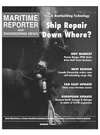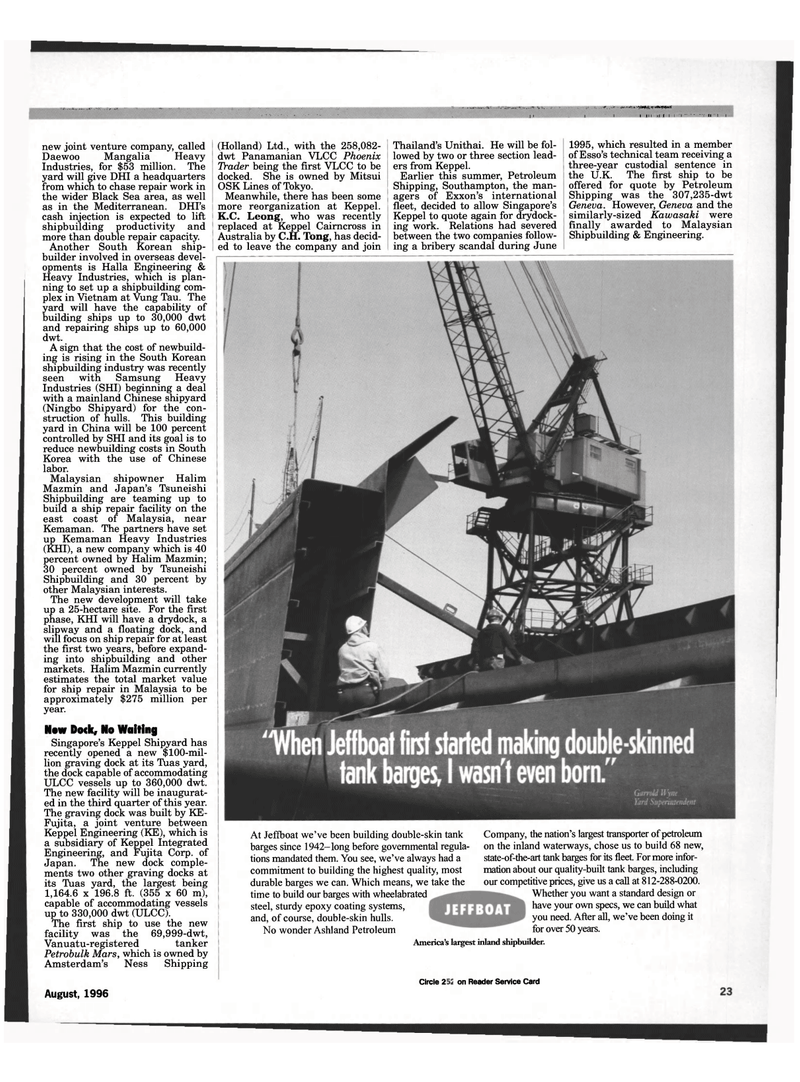
Page 21: of Maritime Reporter Magazine (August 1996)
Read this page in Pdf, Flash or Html5 edition of August 1996 Maritime Reporter Magazine
MMmiiiM. • mum • • m iiiiiiinamn'TOi'nrMfriii hm urn inn iimrrMnnmr I L.J " w«M«»««^«™«aMM«MMMaMBMBIHMaM»MBaWHMBBMMBMBMBMMaBMMMMfl^ ...... ; ; . .... . . : . : : S .K :: : fi « S Si - - 5 ;:: ! ffi :: W
Circle 234 on Reader Service Card
August, 1996 23 new joint venture company, called
Daewoo Mangalia Heavy
Industries, for $53 million. The yard will give DHI a headquarters from which to chase repair work in the wider Black Sea area, as well as in the Mediterranean. DHI's cash injection is expected to lift shipbuilding productivity and more than double repair capacity.
Another South Korean ship- builder involved in overseas devel- opments is Halla Engineering &
Heavy Industries, which is plan- ning to set up a shipbuilding com- plex in Vietnam at Vung Tau. The yard will have the capability of building ships up to 30,000 dwt and repairing ships up to 60,000 dwt.
A sign that the cost of newbuild- ing is rising in the South Korean shipbuilding industry was recently seen with Samsung Heavy
Industries (SHI) beginning a deal with a mainland Chinese shipyard (Ningbo Shipyard) for the con- struction of hulls. This building yard in China will be 100 percent controlled by SHI and its goal is to reduce newbuilding costs in South
Korea with the use of Chinese labor.
Malaysian shipowner Halim
Mazmin and Japan's Tsuneishi
Shipbuilding are teaming up to build a ship repair facility on the east coast of Malaysia, near
Kemaman. The partners have set up Kemaman Heavy Industries (KHI), a new company which is 40 percent owned by Halim Mazmin; 30 percent owned by Tsuneishi
Shipbuilding and 30 percent by other Malaysian interests.
The new development will take up a 25-hectare site. For the first phase, KHI will have a drydock, a slipway and a floating dock, and will focus on ship repair for at least the first two years, before expand- ing into shipbuilding and other markets. Halim Mazmin currently estimates the total market value for ship repair in Malaysia to be approximately $275 million per year. (Holland) Ltd., with the 258,082- dwt Panamanian VLCC Phoenix
Trader being the first VLCC to be docked. She is owned by Mitsui
OSK Lines of Tokyo.
Meanwhile, there has been some more reorganization at Keppel.
K.C. Leong, who was recently replaced at Keppel Cairncross in
Australia by C.H. Tong, has decid- ed to leave the company and join
Thailand's Unithai. He will be fol- lowed by two or three section lead- ers from Keppel.
Earlier this summer, Petroleum
Shipping, Southampton, the man- agers of Exxon's international fleet, decided to allow Singapore's
Keppel to quote again for drydock- ing work. Relations had severed between the two companies follow- ing a bribery scandal during June 1995, which resulted in a member of Esso's technical team receiving a three-year custodial sentence in the U.K. The first ship to be offered for quote by Petroleum
Shipping was the 307,235-dwt
Geneva. However, Geneva and the similarly-sized Kawasaki were finally awarded to Malaysian
Shipbuilding & Engineering.
New Dock, No Waiting
Singapore's Keppel Shipyard has recently opened a new $100-mil- lion graving dock at its Tuas yard, the dock capable of accommodating
ULCC vessels up to 360,000 dwt.
The new facility will be inaugurat- ed in the third quarter of this year.
The graving dock was built by KE-
Fujita, a joint venture between
Keppel Engineering (KE), which is a subsidiary of Keppel Integrated
Engineering, and Fujita Corp. of
Japan. The new dock comple- ments two other graving docks at its Tuas yard, the largest being 1,164.6 x 196.8 ft. (355 x 60 m), capable of accommodating vessels up to 330,000 dwt (ULCC).
The first ship to use the new facility was the 69,999-dwt,
Vanuatu-registered tanker
Petrobulk Mars, which is owned by
Amsterdam's Ness Shipping
At Jeffboat we've been building double-skin tank barges since 1942-long before governmental regula- tions mandated them. You see, we've always had a commitment to building the highest quality, most durable barges we can. Which means, we take the time to build our barges with wheelabrated steel, sturdy epoxy coating systems, and, of course, double-skin hulls.
No wonder Ashland Petroleum
Company, the nation's largest transporter of petroleum on the inland waterways, chose us to build 68 new, state-of-the-art tank barges for its fleet. For more infor- mation about our quality-built tank barges, including our competitive prices, give us a call at 812-288-0200.
Whether you want a standard design or have your own specs, we can build what you need. After all, we've been doing it for over 50 years.
America's largest inland shipbuilder.

 20
20

 22
22
